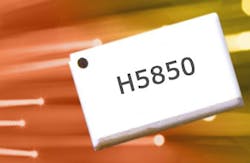Low-power optical modulator driver for 40- and 100-gigabit-per-second applications introduced by Hittite
CHELMSFORD, Mass., 29 May 2012. Hittite Microwave Corp. in Chelmsford, Mass., is introducing the HMC5850BG small, low-power optical modulator driver for 40- and 100-gigabit-per-second optical Mach-Zehnder modulator driver applications. The Hittite optical modulator driver operates from DC to 30 GHz.
The HMC5850BG has high gain across a wide frequency range, low power dissipation, compact size, integrated peak detector function, fast rise-and-fall time and integrated bias-tee inductor. The driver provides eight peak-to-peak voltage saturated output swing to 32 gigabits per second and has output swing cross point adjustment.
With an operating range from five to seven volts, the HMC5850BG consumes one Watt of power. The HMC5850BG provides long-haul system designers with scalable power dissipation for varying output drive requirements.
The integrated peak detector function enables monitoring and maintains a constant output swing from the modulator driver. Integrated high speed bias-tee eliminates the requirement for external components. The HMC5850BG also can interface with the HMC981LP3E active-bias controller to stabilize performance over operating conditions.
The HMC5850BG operates in temperatures from -40 to 85 degrees Celsius, provides as much as 32 dB of gain, and exhibits low additive rms jitter of 230 fs and supports speeds as fast as 32 gigabits per second operation. The output swing is adjustable from five to eight peak to peak.
The HMC5850BG has RF I/Os that are internally matched to 50 Ohms, and are housed in 9.75 by 6 by 3.29-millimeter laminate substrate based BGA surface-mount package. The package comes with ESD protection.
For more information contact hittite Microwave online at www.hittite.com.
Follow Military & Aerospace Electronics and Avionics Intelligence news updates on Twitter

